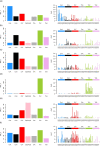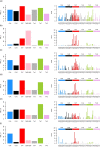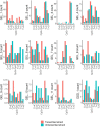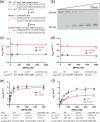Genetic and chemotherapeutic influences on germline hypermutation
- PMID: 35545669
- PMCID: PMC9117138
- DOI: 10.1038/s41586-022-04712-2
Genetic and chemotherapeutic influences on germline hypermutation
Abstract
Mutations in the germline generates all evolutionary genetic variation and is a cause of genetic disease. Parental age is the primary determinant of the number of new germline mutations in an individual's genome1,2. Here we analysed the genome-wide sequences of 21,879 families with rare genetic diseases and identified 12 individuals with a hypermutated genome with between two and seven times more de novo single-nucleotide variants than expected. In most families (9 out of 12), the excess mutations came from the father. Two families had genetic drivers of germline hypermutation, with fathers carrying damaging genetic variation in DNA-repair genes. For five of the families, paternal exposure to chemotherapeutic agents before conception was probably a key driver of hypermutation. Our results suggest that the germline is well protected from mutagenic effects, hypermutation is rare, the number of excess mutations is relatively modest and most individuals with a hypermutated genome will not have a genetic disease.
© 2022. The Author(s).
Conflict of interest statement
M.H. is a co-founder of, consultant to and holds shares in Congenica, a genetics diagnostic company. L.M. and C.O. are employees of Genomics England Ltd.
Figures












Similar articles
-
Parental influence on human germline de novo mutations in 1,548 trios from Iceland.Nature. 2017 Sep 28;549(7673):519-522. doi: 10.1038/nature24018. Epub 2017 Sep 20. Nature. 2017. PMID: 28959963
-
De novo structural mutation rates and gamete-of-origin biases revealed through genome sequencing of 2,396 families.Am J Hum Genet. 2021 Apr 1;108(4):597-607. doi: 10.1016/j.ajhg.2021.02.012. Epub 2021 Mar 5. Am J Hum Genet. 2021. PMID: 33675682 Free PMC article.
-
Parental somatic mosaicism is underrecognized and influences recurrence risk of genomic disorders.Am J Hum Genet. 2014 Aug 7;95(2):173-82. doi: 10.1016/j.ajhg.2014.07.003. Epub 2014 Jul 31. Am J Hum Genet. 2014. PMID: 25087610 Free PMC article.
-
Somatic Mutagenesis in Mammals and Its Implications for Human Disease and Aging.Annu Rev Genet. 2018 Nov 23;52:397-419. doi: 10.1146/annurev-genet-120417-031501. Epub 2018 Sep 13. Annu Rev Genet. 2018. PMID: 30212236 Free PMC article. Review.
-
Properties and rates of germline mutations in humans.Trends Genet. 2013 Oct;29(10):575-84. doi: 10.1016/j.tig.2013.04.005. Epub 2013 May 16. Trends Genet. 2013. PMID: 23684843 Free PMC article. Review.
Cited by
-
SNV/indel hypermutator phenotype in biallelic RAD51C variant - Fanconi anemia.Res Sq [Preprint]. 2023 Mar 2:rs.3.rs-2628288. doi: 10.21203/rs.3.rs-2628288/v1. Res Sq. 2023. Update in: Hum Genet. 2023 Jun;142(6):721-733. doi: 10.1007/s00439-023-02550-4. PMID: 36909564 Free PMC article. Updated. Preprint.
-
Evolution of the Mutation Spectrum Across a Mammalian Phylogeny.Mol Biol Evol. 2023 Oct 4;40(10):msad213. doi: 10.1093/molbev/msad213. Mol Biol Evol. 2023. PMID: 37770035 Free PMC article.
-
The rate of de novo structural variation is increased in in vitro-produced offspring and preferentially affects the paternal genome.Genome Res. 2023 Sep;33(9):1455-1464. doi: 10.1101/gr.277884.123. Epub 2023 Oct 4. Genome Res. 2023. PMID: 37793781 Free PMC article.
-
"Evolution of the mutation spectrum across a mammalian phylogeny".bioRxiv [Preprint]. 2023 Jun 1:2023.05.31.543114. doi: 10.1101/2023.05.31.543114. bioRxiv. 2023. Update in: Mol Biol Evol. 2023 Oct 4;40(10):msad213. doi: 10.1093/molbev/msad213. PMID: 37398383 Free PMC article. Updated. Preprint.
-
The importance of family-based sampling for biobanks.Nature. 2024 Oct;634(8035):795-803. doi: 10.1038/s41586-024-07721-5. Epub 2024 Oct 23. Nature. 2024. PMID: 39443775 Free PMC article.
References
MeSH terms
Grants and funding
LinkOut - more resources
Full Text Sources
Medical

